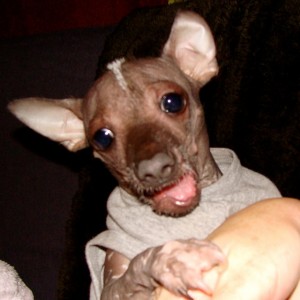 So, in our homebrewing “fantasy league,” the wife and I came up with a bunch of names for our craft brews … mostly named after the pets or inspired by ancient culture. Among these is what we aspire to perfect: Tilted Jaw IPA. The wife and I are both big hop heads (despite my predilection for all things ancient and there having not been hops in ancient ales), so a tasty IPA homebrew is a must. And following our inclination for the pets as the naming convention, “tilted jaw” reflects not only the desirable mouth effect I hope the IPA will garner, but also the visual peculiarity of our cute little puppy Sputnik.
So, in our homebrewing “fantasy league,” the wife and I came up with a bunch of names for our craft brews … mostly named after the pets or inspired by ancient culture. Among these is what we aspire to perfect: Tilted Jaw IPA. The wife and I are both big hop heads (despite my predilection for all things ancient and there having not been hops in ancient ales), so a tasty IPA homebrew is a must. And following our inclination for the pets as the naming convention, “tilted jaw” reflects not only the desirable mouth effect I hope the IPA will garner, but also the visual peculiarity of our cute little puppy Sputnik.
Since I feel I’m still getting my feet wet in the homebrewing arena, I continue to lean towards the Brewer’s Best ingredient kits as a base, but I can’t just brew a batch straight from the ingredients provided in the kit. Must tweak!
Wines and grogs of the ancient world sometimes incorporated evergreen tree sap in the brew as a preservative, flavoring agent, and a sealant for the porous earthenware fermenting vessels (kinda like a glaze). Hence the famous Greek retsina. A slightly piney pale ale sounds pretty appealing to me, so I got to thinking it would be nice to use a hops with a somewhat piney characteristic. The gents at Brew and Grow turned us toward Chinook hops with its “mild to medium-heavy, spicy, distinct piney aroma” (alpha acid 11.1%). We also got Wyeast’s Belgian Ardennes yeast just because the dude at the store suggested it. The latter in hindsight turned out to be a mistake, in my opinion, but it’s a learning experience.
As per the Brewer’s Best IPA kit that we used for the Full Moon Half-Caf IPA, the kit included the following ingredients and supplies:
- 6.6 lbs (3 kg) Munton’s light malt extract
- 1 lb (454 g) light spray malt extract
- 1 lb (454 g) crushed Caramel 40L malted barley*
- 8 oz (226.8 g) crushed Victory malted barley*
- 1.5 oz (42.52 g) Columbus bittering hops, 15.2% alpha acid**
- 2 oz (56.7 g) Cascade bittering hops, 6.4% alpha acid**
- 1 oz (28.35 g) Cascade aroma hops, 6.4% alpha acid**
- 1 packet (0.388 oz, 11 g) Lallemand Nottingham dried ale yeast***
- 5 oz (141.75 g) priming corn sugar (for bottle conditioning)
- 60 bottle caps
- A mesh grain bag (like a cheap stocking not suitable for reuse)
- 1 double-sided sheet of brewing instructions
- Miscellaneous things. Thank you Inspector #9.
We swapped out the Lallemand Nottingham dried yeast with the Wyeast Belgian Ardennes liquid yeast. We also swapped out 1 oz of Cascade hops (6.4% alpha acid) with 1 oz of Chinook hops (11.1% alpha acid) at the aroma stage (5 minutes before flame out). So, the following is the recipe we actually followed:
- 6.6 lbs (3 kg) Munton’s light malt extract
- 1 lb (454 g) light spray malt extract
- 1 lb (454 g) crushed Caramel 40L malted barley*
- 8 oz (226.8 g) crushed Victory malted barley*
- 1.5 oz (42.52 g) Columbus hops for bittering, 15.2% alpha acid**
- 2 oz (56.7 g) Cascade hops for bittering, 6.4% alpha acid**
- 1 oz (28.35 g) Chinook hops for aroma, (11.1% alpha acid)**
- 1 packet Wyeast Belgian Ardennes liquid yeast
- 5 oz (141.75 g) priming corn sugar (for bottle conditioning)
*See John Palmer’s How to Brew, chapter 12.1, “Malt Types” for concise malt definitions.
**See John Palmer’s How to Brew, chapter 5.3, “Hop Types” for brief hop descriptions.
***See John Palmer’s How to Brew, chapter 6.4.1, “Dry Yeast Strains” for description.
I had hoped using Chinook for the aroma stage would bring out a greater piney aroma, but the pine notes haven’t been all that apparent in this batch. Next time I’ll use Chinook for bittering, which is what it seems to be meant for. I’ll likely also use at least a couple ounces.
Yeast
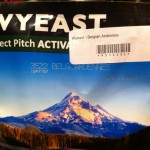 The Belgian yeast was also a big disappointment. The Belgian yeasty aroma and flavor is completely overpowering, and I’m not a fan of Belgian ales to begin with. I should have known better. I’ve been pretty happy with the Lallemand dried yeasts so far. The trick is to rehydrate them, which we’ve always done. Per the instructions in Charlie Papazian’s The Complete Joy of Homebrewing, 3rd edition:
The Belgian yeast was also a big disappointment. The Belgian yeasty aroma and flavor is completely overpowering, and I’m not a fan of Belgian ales to begin with. I should have known better. I’ve been pretty happy with the Lallemand dried yeasts so far. The trick is to rehydrate them, which we’ve always done. Per the instructions in Charlie Papazian’s The Complete Joy of Homebrewing, 3rd edition:
…[Boil] 1 1/2 cups (355 ml) of water for 5-10 minutes, pour into a sanitized glass jar (washed and boiled for about 15 minutes), cover with clean foil and let cool to 100-105 degrees F (38-41 C). Do not add any sugars. Add dried yeast and let rehydrate for 15-30 minutes, and then bring the temperature of the rehydrated yeast close to that of the wort and pitch. (Page 81)
I’ll grant that it was less fuss with the liquid yeast. There are also a lot more strains of liquid yeast available to influence ones brew, but first I would prefer to get my choices of hops and malt down right for the Tilted Jaw.
The liquid Belgian yeast was also far more active than any of the dry yeasts I’ve used so far. After just 12 hours, there was a lot of overflow coming through the airlock and I had to add a blowout hose relieve the pressure and get rid of the foamy overflow.
We brewed on July 7, 2012. Original gravity was 1.063. We bottled on July 18. 2012. Final gravity was 1.1014. This yields an ABV of 6.43%. I can live with that. But I certainly look forward to Tilted Jaw’s 2nd attempt.
Cheers!
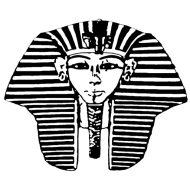
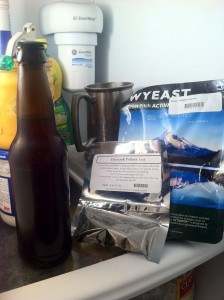
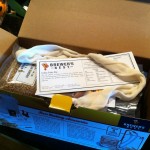
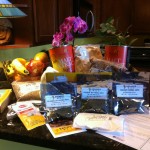
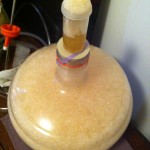
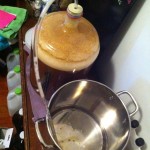
Leave a comment